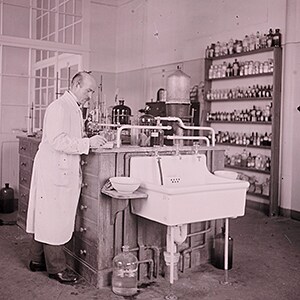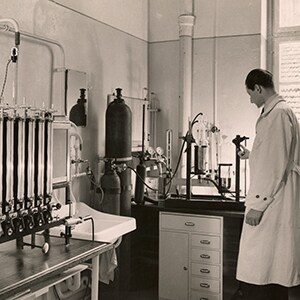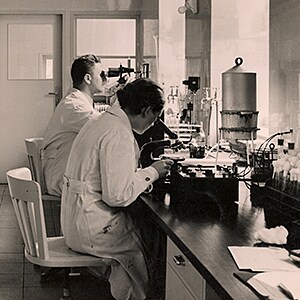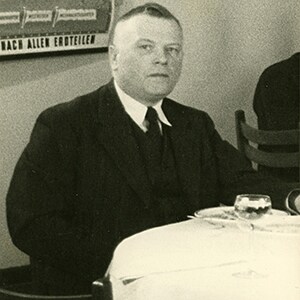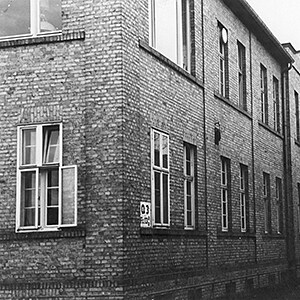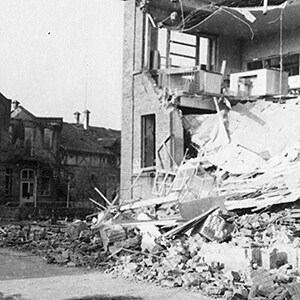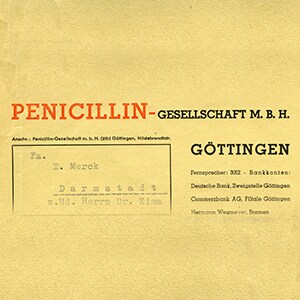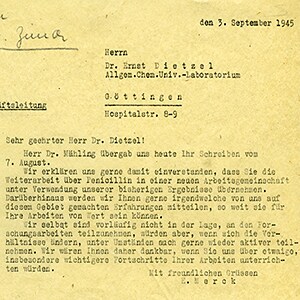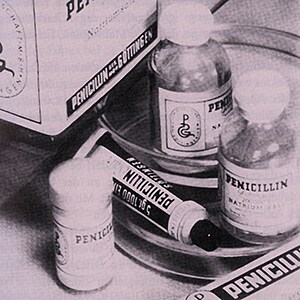
textblock default title
»[Penicillin], which we already held in our hands…«
A company head of research after the end of the war in 1945
The discovery of penicillin by the bacteriologist Alexander Fleming in 1928 is serendipitous, like many advances in science. During experiments with staphylococci, a Petri dish accidentally becomes contaminated with fungal spores which go on to form a substance that inhibits bacterial growth. Fleming calls it »penicillin«.
Another 10 years will pass before his discovery is taken up again. Costly research is undertaken and pushed forward mainly in the United Kingdom and the United States. However, not many people know that the company has a penicillin research program of its own during World War II.
The company’s experience in using microbiological methods dates back to the 19th century. Experiments exploring the use of acetic acid bacteria to produce ascorbic acid have been ongoing since the 1930s; a method developed by a Swiss research scientist named Tadeus Reichstein is successfully implemented in Darmstadt. Existing biotech expertise is therefore available.
In June 1943, Theodor Moll, a veterinarian, launches experiments at the company to study the bacteriological activity of metabolic products of fungal cultures. Moll isolates 300 strains and screens them for formation of an antibiotic active ingredient. In November 1944, he succeeds in manufacturing 70 milligrams of calcium penicillin, a dry yellow powder. This product is tested successfully in animals but not given to patients yet.
An air raid on December 12, 1944 targeting the Darmstadt site puts an abrupt and tragic end to Moll’s work. Moll and his staff are killed and the lab is destroyed, likewise a 50-liter penicillin plant undergoing construction and the small quantities of penicillin that had already been produced.
The company is unable to establish penicillin production facilities of its own after the war. The site lies largely in ruins and funds are scarce. Other research scientists are able to benefit from Moll’s work, however. Efforts to salvage a number of penicillin strains from the rubble were successful. The best »penicillin breeder«, fungal strain 318, survives.
The company provides a culture from fungal strain »318«, a culture from the test pathogen Staphylococcus aureus with the strain designation »SG 511«, and a standard operating procedure on penicillin isolation to support the research activities of the Goettingen-based »Penicillin Working Group«. The latter gives rise to the »Penicillin Company«, one of the first German manufacturers of penicillin vials, wound powder and ointments in 1946. The hopes of a promising field of work for the company are in ruins but a valuable contribution to research prevails.
The first serious bacteriological experiments on penicillin are carried out at the company under the supervision of veterinarian Theodor Moll in 1943. However, the complex and costly penicillin research does not produce any promising batches.
Although the company succeeds in producing penicillin calcium in November 1944, only a month later Theodor Moll and many of his staff members are killed in an air raid on the Darmstadt site during World War II and their laboratories are destroyed, thus marking the end of penicillin research at the company.
The company does full justice to its responsibility as a research-based company: The head of the Goettingen-based »Penicillin Working Group«, later on the »Penicillin Company«, preserves material salvaged from the rubble during a visit to Darmstadt in October 1945 and uses it for further research.

